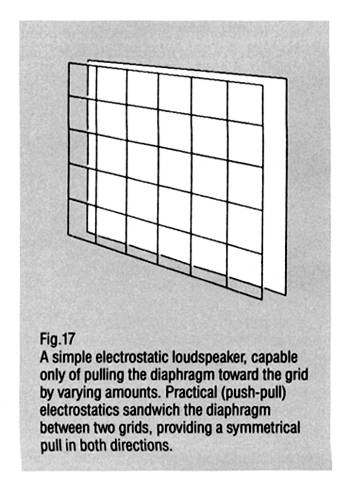| Columns Retired Columns & Blogs |
Audio Basics: A Is For Ampere Page 8
Transduction
This formidable-sounding word simply means changing one form of energy into another. A cartridge transduces the little mechanical squiggles in a record groove into electrical signals, and a loudspeaker transduces amplified electrical signals into soundwaves.
This formidable-sounding word simply means changing one form of energy into another. A cartridge transduces the little mechanical squiggles in a record groove into electrical signals, and a loudspeaker transduces amplified electrical signals into soundwaves.
Transduction is possible because certain interactions between electrons or between magnetic fields create physical forces. There are two approaches in general use: electrodynamic and electrostatic.
Electrodynamic (dynamic for short) transducers are based on two properties of magnetism: 1) Magnetic poles attract or repel each other, depending on their relative polarity, and 2) Current flow through a coil produces magnetism. Identical magnetic poles repel and opposite poles attract, and the direction of current flow though a coil determines the polarity of its magnetic field. So if we take an unchanging magnetic field, place a coil within it, and pump an audio signal through the coil, the result is a series of alternating forces between the two. If either the magnet or the coil is fixed (usually the magnet) and the other isn't (usually the coil), the latter will vibrate along with anything attached to it that looks like a cone or a dome. That's called a loudspeaker (fig.16).

Like most other things in physics, this will work backwards. If we use a pickup stylus to vibrate a coil within a constant magnetic field---a moving-coil pickup---their relative movements will cause currents to flow back and forth through the coil, and we can then feed those into our phono preamp and listen to Beethoven. Likewise, we can arrange the stylus to shake a magnet next to a fixed coil---this is how a moving-magnet pickup cartridge generates an electrical signal.
Electrostatic transducers are based on the fact that electrons, like intellectual faculties, are attracted to their own deficiency. The electrostatic fields of a charged capacitor's plates attract one another because of the electron-density difference between them. Most people have seen what this does, although they haven't the vaguest notion what causes it. Certain items of clothing, notably nylon fabrics, cling tenaciously together when removed from a clothes dryer. (Unless you've used some proprietary products to combat what Madison Avenue calls "static cling.")
If we take a grid of wires arranged in a plane, suspend a thin sheet of flexible, electrically conductive material near to and parallel with it (fig.17), with only air separating them, and then charge the two like a capacitor, the electron-density difference will attract the sheet (the diaphragm) to the grid. If the charging voltage is an audio signal, the varying attractions will cause the diaphragm to vibrate, producing soundwaves. There's a lot more to electrostatic loudspeaker design than that, but that's basically how all such speakers work.

Soundwaves
Finally, we get to the nitty gritty.
Sound is our perception of rapid changes in air pressure, from around 20 changes per second to 20,000. Anything which pushes rapidly against the surrounding air creates a compression front, which then travels away from the source in all directions until it is absorbed by something (tree leaves, for example) or spreads itself so thin as to vanish. The speed of this wavefront motion is pretty much constant, at around 1100 feet per second at sea level. The air molecules themselves don't move continuously from the sound source; what they do is shift momentarily away from the source as the compression passes (at 1100 ft/s), then move back to their original positions.
Physical vibration is the repetitive sinusoidal motion of any object, which produces a series of these traveling wavefronts in which air pressure varies above and below the atmospheric (barometric) pressure. The physical wavelength---the distance between successive waves---of a sound is equal to the speed, 1100 ft/s, divided by its frequency, thus a pure sinewave with a frequency of 1100Hz will have the wave peaks or troughs spaced a foot apart.
- Log in or register to post comments




































